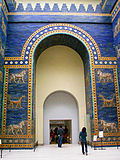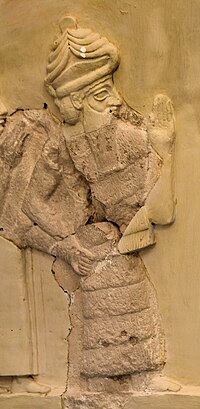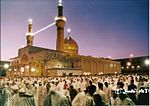The mušḫuššu (𒈲𒍽; formerly also read as sirrušu or sirrush) or mushkhushshu (pronounced [muʃxuʃʃu] or [musxussu]) is a creature from ancient Mesopotamian...
7 KB (608 words) - 15:51, 31 October 2024
temple Esagila. His symbol is the spade and he is associated with the Mušḫuššu. By the 1st millennium BC, Marduk had become astrologically associated...
48 KB (6,681 words) - 23:46, 29 December 2024
was constructed using glazed brick with alternating rows of bas-relief mušḫuššu (dragons), aurochs (bulls), and lions, symbolizing the gods Marduk, Adad...
27 KB (3,504 words) - 11:58, 24 December 2024
Mušḫuššu (sirrush) and aurochs on either side of the processional street. Ancient Babylon, Mesopotamia, Iraq....
98 KB (10,998 words) - 03:57, 26 December 2024
animals in Babylon: a contextual approach to the lion, the bull and the mušḫuššu". Iraq. 77: 215–224. doi:10.1017/irq.2015.17. Jackson, pp. 109, 115. Borowski...
147 KB (16,037 words) - 02:06, 23 December 2024
Hellenistic Period (323 BC–31 BC). This creature, known in Akkadian as the mušḫuššu, meaning "furious serpent", was used as a symbol for particular deities...
27 KB (3,568 words) - 02:51, 22 December 2024
father Ninazu, he was also associated with snakes, including the mythical mushussu, ushumgal and bashmu and in one case Nirah. He was also an underworld god...
18 KB (2,209 words) - 02:16, 4 September 2024
Indo-European mythologies. Famous prototypical draconic creatures include the mušḫuššu of ancient Mesopotamia; Apep in Egyptian mythology; Vṛtra in the Rigveda;...
110 KB (12,362 words) - 19:28, 30 December 2024
gods and the slayer of Tiamat, then was considered the ruler of all gods. Mušḫuššu A creature from ancient Mesopotamian mythology found on Ishtar Gate. A...
45 KB (911 words) - 04:25, 2 November 2024
Hellenistic period (323 BCE–31 BCE). This creature, known in Akkadian as the mušḫuššu, meaning "furious serpent", was used as a symbol for particular deities...
65 KB (8,398 words) - 15:23, 23 December 2024
decorations are symbols of lions (associated with the goddess Ishtar) flowers, mušḫuššu (a mythological creature associated with the god Marduk) and oxen (associated...
77 KB (9,758 words) - 13:21, 29 December 2024
(Chapter 13) Lotan, the seven-headed sea serpent or dragon of Ugaritic myths Mušḫuššu The horse in Nordic mythology Revelation 12:9 Charting the End Times: A...
46 KB (6,066 words) - 15:43, 26 December 2024
animal. Egyptian mythology List of hieroglyphs/C List of hieroglyphs/E Mušḫuššu Peribsen and Khasekhemwy—for the history of the Set animal mounted upon...
19 KB (2,050 words) - 03:45, 22 December 2024
Late Assyrian seal. Worshipper between Nabu and Marduk, standing on their servant dragon Mušḫuššu, eighth century BCE....
74 KB (8,591 words) - 20:50, 30 November 2024
The dragon Mušḫuššu on a vase of Gudea, circa 2100 BCE....
41 KB (4,129 words) - 06:22, 7 October 2024
apotropaic rituals, Lahmu was associated with other monsters, for example mušḫuššu, bašmu (a type of mythical snake), kusarikku (bison-men associated with...
6 KB (720 words) - 07:45, 13 October 2024
Hellenistic Period (323 BC–31 BC). This creature, known in Akkadian as the mušḫuššu, meaning "furious serpent", was used as a symbol for particular deities...
152 KB (15,153 words) - 18:56, 27 December 2024
The god Marduk and his dragon Mušḫuššu...
43 KB (5,798 words) - 00:55, 15 December 2024
Late Assyrian seal. Worshipper between Nabu and Marduk, standing on their servant dragon Mušḫuššu, eighth century BCE....
11 KB (1,036 words) - 05:42, 22 October 2024
She was believed to be the daughter of An. Mušḫuššu Ninazu, Ningishzida; Tishpak; Marduk, Nabu; Ashur Mušḫuššu ("furious snake" or "awful snake") was a...
247 KB (11,060 words) - 19:14, 26 November 2024
('Venomous Snake'), Ušumgallu ('Great Dragon'), Mušmaḫḫū ('Exalted Serpent'), Mušḫuššu ('Furious Snake'), Laḫmu (the 'Hairy One'), Ugallu (the 'Big Weather-Beast')...
18 KB (2,161 words) - 22:40, 25 December 2024
The god Marduk and his dragon Mušḫuššu...
33 KB (3,550 words) - 08:57, 17 December 2024
"serpent" constellations in Babylonian astronomy, known as Mušḫuššu and Bašmu. It appears that Mušḫuššu was depicted as a hybrid of a dragon, a lion and a bird...
119 KB (11,804 words) - 17:42, 6 November 2024
human and non-avian dinosaur coexistence have equated the Mesopotamian mušḫuššu, a legendary chimeric creature, with dinosaurs. Robert Koldewey, the discoverer...
18 KB (2,065 words) - 09:30, 25 December 2024
ISSN 1004-9371. Wiggermann, Frans A. M. (1989). "Tišpak, his seal, and the dragon mušḫuššu". To the Euphrates and beyond: archaeological studies in honour of Maurits...
102 KB (14,074 words) - 19:42, 28 December 2024
deity, but he was also associated with snakes, including the mythical mushussu and bashmu, and with kingship. Tishpak was of neither Sumerian nor Akkadian...
29 KB (3,650 words) - 19:41, 28 December 2024
trade contacts with India. The "Libation vase of Gudea" with the dragon Mušḫuššu, dedicated to Ningishzida (21st century BC short chronology). The caduceus...
15 KB (1,265 words) - 08:25, 17 November 2024
sauropod-like creature with purple crystals protruding from its hide. Altamaha-ha Mušḫuššu Cryptid Human–dinosaur coexistence Living dinosaur Loch Ness Monster Lariosauro...
20 KB (2,603 words) - 22:24, 14 December 2024
may be a different local god by the same name. His divine beast was the mušḫuššu, a kind of dragon, which was later given to Tishpak and then Marduk. Ningishzida...
28 KB (3,341 words) - 06:15, 7 October 2024
Hadad, Leviathan and Yahweh, Tiamat and Marduk (see also Labbu, Bašmu, Mušḫuššu), Illuyanka and Tarhunt, Yammu and Baal in the Baal Cycle etc. The Hebrew...
23 KB (2,495 words) - 10:38, 11 December 2024
























